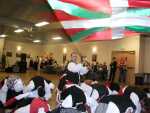Basques celebrate during 50th Annual Sheepherders' Ball

Hundreds of Basques packed into the local Elks Lodge to honor their culture and share it with others during the 50th Annual Basque Sheepherders' Ball last Saturday.
Held just a block from the city's historic Basque district, the evening featured food, music and dancing unique to this ethnic European culture.
As members of the Basque community arrived at the lodge shortly before the evening's scheduled entertainment, people like Mary Zocholl were busy preparing ethnic favorites for the growing crowd, including chorizo, a fried Basque sausage.
While people ate and socialized, the Oinkari Dancers from Boise showcased traditional Basque dances in the lodge's main banquet hall. The opening performances included the Arin Arin -- a social dance for young men and women. The Oinkari dance team then moved into groups of four to demonstrate the Kadril, which originated in the Basque province of Navarra.
Other dances focused on the coming of spring and the hope of new beginnings. Young women carrying wooden hoops decorated with brightly colored flowers performed the Ustai, or girls hoop dance. Afterward, the young men and women ducked beneath the May Pole, showcasing the Zinta, or spring dance.
The evening's performances culminated with the Ikurriņa, or flag dance. P.J. Mansisidor swung the Basque flag back and forth above the members of the dance troupe as they bowed in reverence to their native homeland.
More photo's available in the Mountain Home News Photo Gallery
According to members of the dance troupe, the Ikurriņa remains an important symbol of the Basque people. For years, this dance was banned in their native country as Spanish dictator Francisco Franco tried to suppress their culture, they said.
For Basques visiting the United States from their homeland, the Ikurriņa continues to generate both cheers and tears for these people as they reflect on those years of oppression, group members added.
Home to one of the world's oldest democracies, the Basques include approximately 3 million people living in a region about the size of Rhode Island nestled between France and Spain. In the late 19th and early 20th centuries, Basques began to immigrate to the United States seeking a better life. Those that settled in southern Idaho found work in the sheep industry with many owning their own herds and related businesses.
At the end of each winter lambing season, many Basques would gather for a festival of song and dance. The event eventually grew into the more formal Sheepherders' Ball that carries on traditions and heritage brought from the Basque homeland.
Today, this ethnic group remains a fixture in the local community with roughly 800 Basques living in Mountain Home, making it the second largest community of its kind in southern Idaho. In fact, more Basques live in the Treasure Valley area than anywhere else in the world outside of the Basque homeland.
